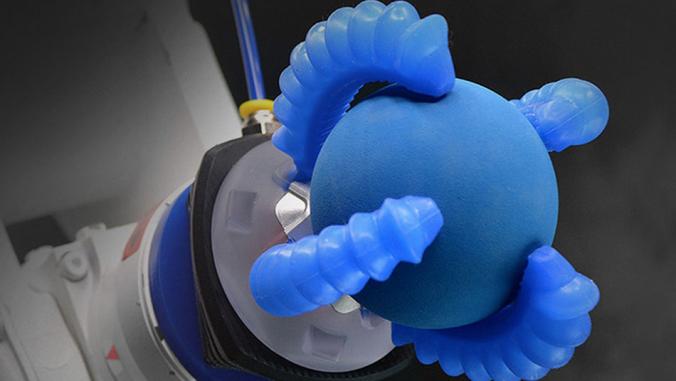Building as a Verb: Designing a Building That Works Harder for You
<p>A more functionally organic building will be able to do more things. In other words, it will be a “verb,” and the distinction between shelter and tool will become blurred as workers make use of the material structure around them to communicate, transport, inform and manipulate in both individual and collective ways.</p> <p> </p> <p> </p> <p> <meta charset="utf-8" /> </p>

Blueprint - CC license by Flickr user Todd Ehlers
What do you get when you throw 60 young architects into a room for 10 days and teach them new parametric software tools, concepts about bio-inspired design, and give them a bunch of servo-motors, sensors and actuators to play with? Well, you get some pretty excited designers, for one thing, and you get some pretty interesting results, for another.
I spoke about bio-inspired design recently to the international participants of such a workshop, Biodynamic Structures, hosted by the California College of the Arts (CCA) and the Architectural Association of London. The purpose of the workshop was to explore the integration of new ideas and technology in the design of better buildings. Can learning more about materials, biology and robotics inspire productively innovative designs? The participants were there to find out in a hands-on approach that included building their own working mechanisms.
Their creations ranged from a ceiling that changed shape when stimulated by noise, to a wall that responded to the presence of people, to a light-activated hydraulic partition, to structural columns that mimicked the distribution of trees and branches in a forest. All were creative and ambitious, and all were developed with that breakneck reflection peculiar to architects in a charrette.
Why is this important to any business? A “smarter” building will make you money, and just might help save your kids and grandkids from living like astronauts on a dead planet. Half of the world's population now lives in urban areas. Buildings and infrastructure in North America account for about 40 percent of material consumption and about a third of energy use. Saving energy, manpower and materials through the use of real-time building information is a business trend that will continue unabated and is reason alone to embrace this long-term strategy.
There is an additional architectural trend, in my opinion, that may become as compelling. It is not in stride yet, but is evidenced in myriad developments in other technologies and in the nascent design efforts of young architects such as these at universities and firms around the world. It is the growing design focus on the human/machine interface. Unlike past utopian (or dystopian) dreamers, however, proponents seek to make the mechanistic more organic, rather than the other way 'round. The key to this approach, of course, is biomimetics and our greater capacity to understand nature.
A more functionally organic building will be able to do more things. In other words, it will be a “verb,” and the distinction between shelter and tool will become blurred as workers make use of the material structure around them to communicate, transport, inform and manipulate in both individual and collective ways. One needs only to look at the revolution in personal communication to appreciate the steep trajectory of change possible for buildings and the people sheltered within.
Professor Jason Johnson thinks that this kind of workshop represents the new trend toward “dynamism.” He sees a growing shift from the making of forms based on a discrete aesthetic, to forms that are “more continuous, interactive with the user, and that allow (themselves) to be modulated by the users. In the past, the users have been the 'actuators,' but now buildings will be more responsive and allow participation with users. Instead of users chasing the building, the building will begin to understand you.”
Architects have long advocated good design as a path to better human performance: Efficient layouts, well-considered circulation, etc. What if your building not only made you more efficient, but also made you smarter? I doubt augmented reality, for example, will be contained for very long within small, hand-held devices. The opportunity for architects (and those benefiting from their designs) is unclear but it will be unique to buildings.
Only within buildings can the electronic extension of self now include a collective experience that directly relates to the physical environment. Several elements of a new approach to architecture were on display at this very successful event: Buildings as responsive mechanisms, nature as a model for these mechanisms, the use of advanced CAD modeling methods for design, and the integration of electronics into typically static scale models.
Participants were trained in several parametric modeling methods like Rhino and Grasshopper, treated to lectures by George Jeronimidis, a pioneer in European biomimetics and director of the Center for Biomimetics at the U.K.'s University of Reading, and Michael Weinstock, director of the Emergent Technologies Programme at the Architectural Association and author of “The Architecture of Emergence: The Evolution of Form in Nature and Civilization."
They were tutored intensely by an accomplished faculty: Jason Kelly Johnson and Andrew Kudless, assistant professors at CCA; Christina Doumpioti and Evan Greenberg, tutors from the Architectural Association's Emergent Technologies Programme; Andrew Payne of LIFT Architects and Harvard University; Daniel Segraves of Adrian Smith + Gordon Gill Architecture; and Daniel Piker of the Kangaroo Live Physics project.
Unique to this event was the blend of deeper training in the practical (parametrics and robotics) and the exposure to a wider range of the conceptual (biomimetics, materials). Parametric modeling, of the type offered in this workshop, has biological models itself. It is the use of iterative formulas reflecting conditions (or parameters) to create patterns or forms and reflects some types of natural self-organization of which I have written. Users are able to generate many different forms quickly from the internal analysis of conditions and interrelationships that the software program provides.
Herein lies their wider significance for sustainability. As Professor Kudless explained, "Particularly in preconstruction, the use of parametrics allows more analysis cycles for design ideas within a typically limited budget.”
Limited budgets mean limited time, and this was certainly replicated at this event. Student teams were challenged to redesign part of the main San Francisco campus building at CCA and present a working model of a responsive building “intervention” within less than a week. Needless to say, no one slept. What impressed me and several of the faculty members was the seriousness of the efforts and the professional endurance of the participants.
One of the better projects was a ceiling system that sensed noise and then adjusted its shape to modulate the noise to an optimum level. It was constructed of tetrahedron shaped “dentils” that could automatically drop down, thus exposing more noise-absorptive surface area as sensors picked up signals. The ceiling could be modulated depending on the direction and intensity of the noise.
What impressed Professor Kudless was that the solution started simply and could therefore be more universally applied to, say, wind or lighting. There was a clear abstraction of natural principles, and there was a clear evolution of shape and form, once the basic thesis was chosen: Increase or decrease surface area in order to mitigate a condition. Certainly in nature there are countless examples of changing surface area to modulate external conditions. Your skin, for example, partly modulates temperature this way.
Not all the projects went this smoothly. Many were not able to get their mechanisms up and running by the time of the final presentation, but it was thrilling to me to see this kind of creative effort to turn the buildings we use into more responsive, organic environments. To be sure, the profession has a long way to go before your company wears a building like a suit of work clothes, but the promise is there. The lessons learned at events like the Biodynamic Structures workshop are therefore worth noting. Liken it to watching the Wright brothers crash their plane a few times. If you're smart, you'll keep watching.
Tom McKeag teaches bio-inspired design at the California College of the Arts and University of California, Berkeley. He is the founder and president of BioDreamMachine, a nonprofit educational institute that brings bio-inspired design and science education to K12 schools.
Blueprint - CC license by Flickr user Todd Ehlers





